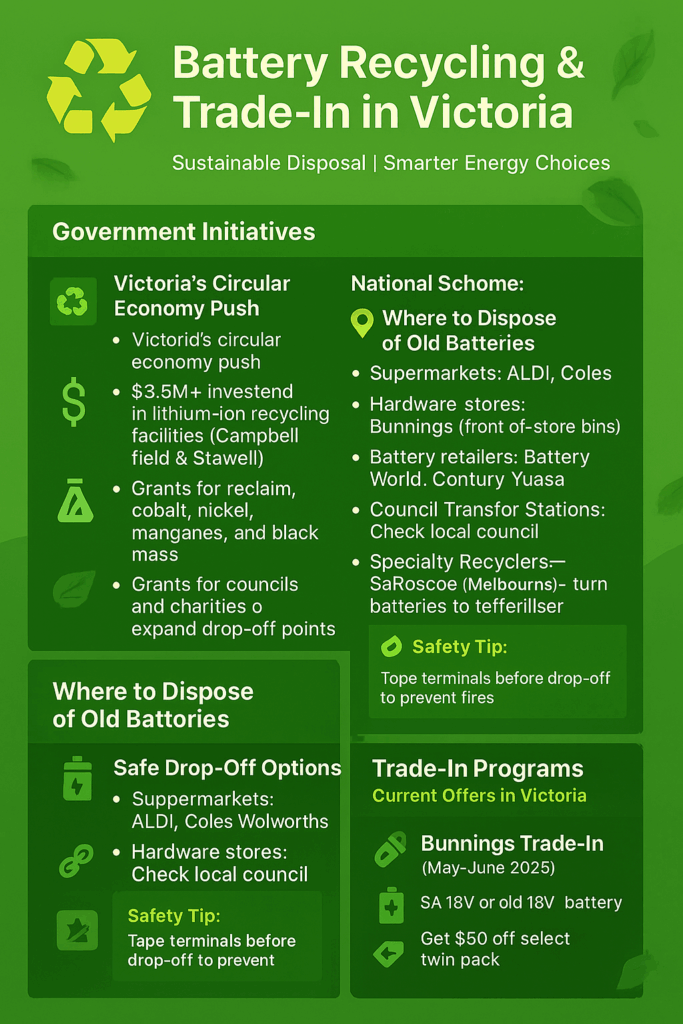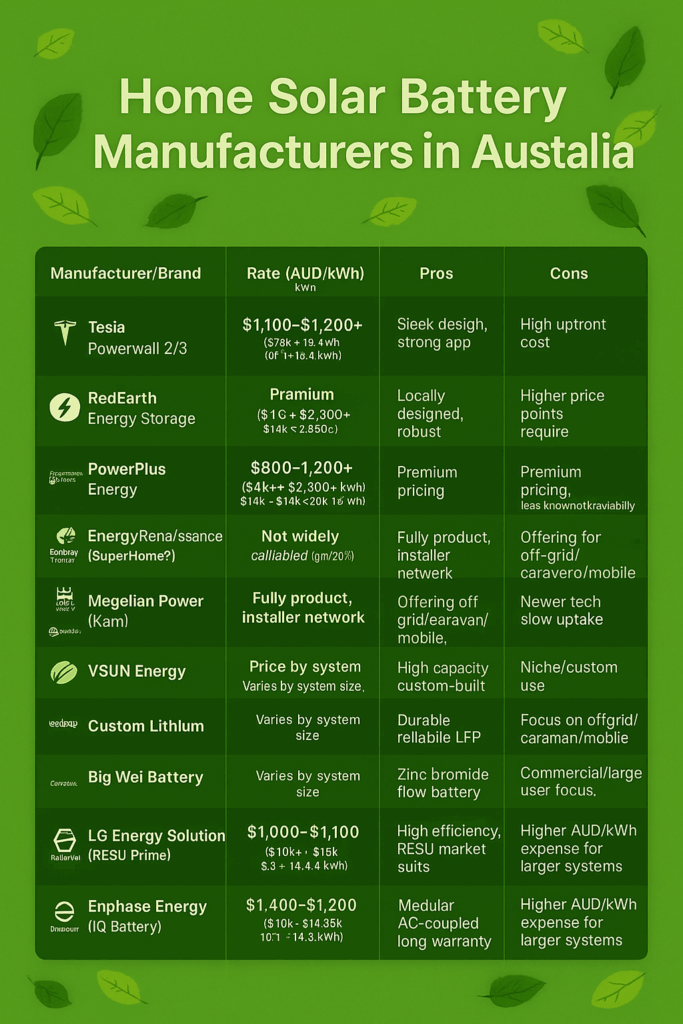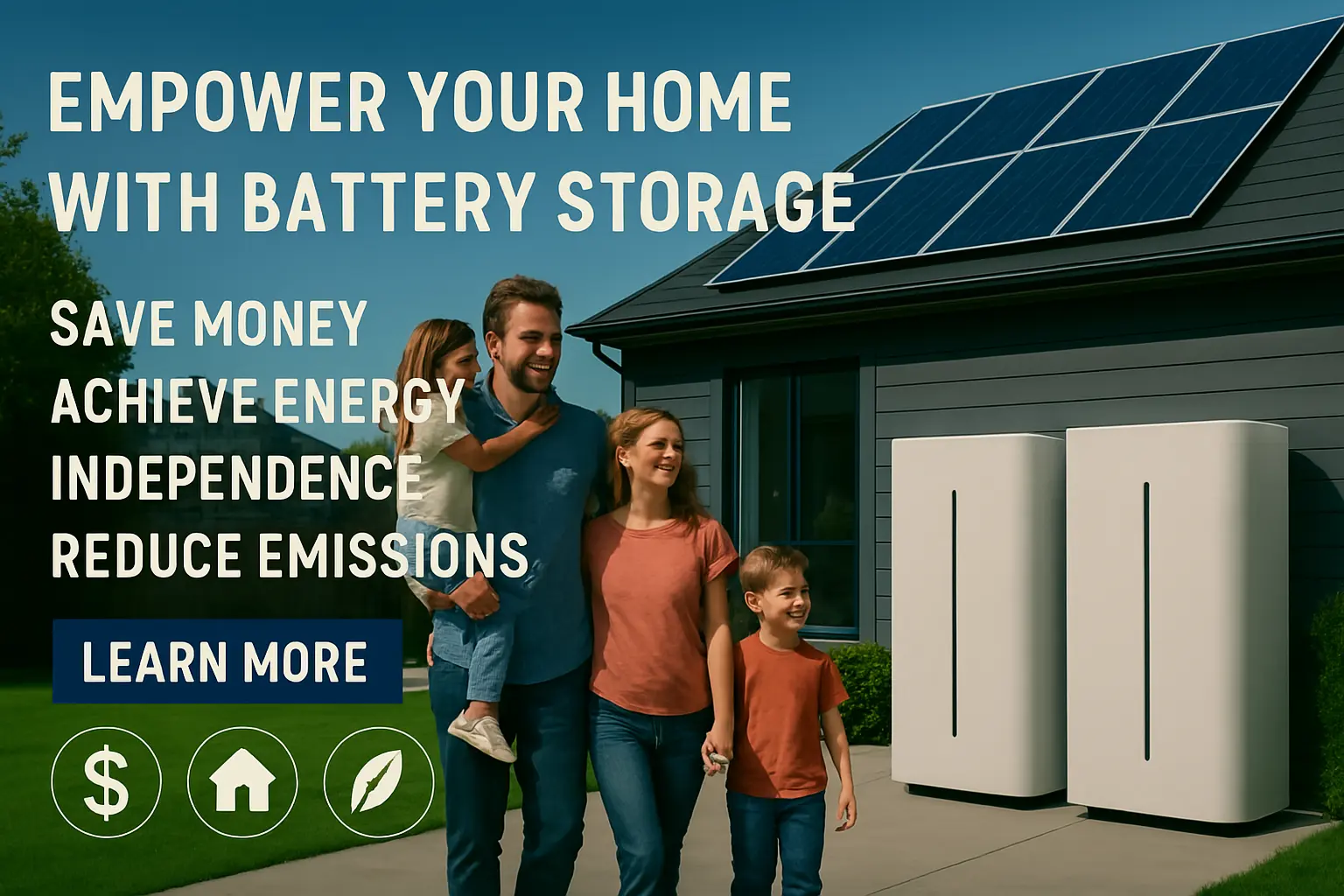As electricity prices surge past $0.30 per kWh and solar installations reach record numbers across Victoria, homeowners are discovering that energy storage is the missing piece of their renewable energy strategy. Solar battery systems transform intermittent solar power into 24/7 energy independence while delivering substantial savings on increasingly expensive grid electricity. With 2025’s unprecedented combination of federal rebates and state financing, Victorian families can now access premium battery technology at historically low costs.
Solar Batteries: The Central Nervous System of Smart Victorian Homes
Modern solar battery systems function as sophisticated energy management hubs that optimize every kilowatt-hour of power flowing through your home. Unlike simple backup generators, these intelligent systems continuously analyze electricity prices, weather patterns, and household consumption to maximize savings and ensure uninterrupted power supply.
🔋 The Daily Energy Cycle in Battery-Powered Victorian Homes
☀️ Morning to Afternoon (Peak Solar Hours)
Rooftop panels generate electricity to power immediate household needs. Surplus energy charges your battery system. Advanced algorithms prioritize essential loads and optimize charging rates based on weather forecasts.
🌇 Evening Peak Period (4–9 PM)
When grid electricity costs soar to $0.45+ per kWh, your battery seamlessly supplies stored solar power. This powers air conditioning, cooking, and entertainment systems—avoiding premium grid rates entirely.
🌙 Overnight and Early Morning
Battery systems provide quiet, emissions-free power for refrigeration, security systems, and EV charging. All powered by sunshine captured the previous day.
🤖 Smart Appliance Scheduling
Smart integration allows Victorian households to automate high-energy appliances—like dishwashers and pool pumps—to run exclusively on stored solar power. This maximizes both savings and environmental benefits.
The Economic Reality Driving Victorian Battery Adoption
📈 Why Prices Are Rising
Victoria’s electricity market faces volatility from coal plant closures, renewable transition costs, and aging infrastructure. Wholesale prices have increased 41.7% year-on-year, with retail customers hit even harder.
🔥 Summer Price Spikes
During summer, air conditioning demand peaks just as grid rates surge. Battery storage shields households from these spikes by supplying stored solar energy during expensive periods.
💡 How Batteries Protect You
Battery systems enable households to consume stored energy when grid prices are highest—reducing dependency and increasing control.
💰 10-Year Savings Snapshot
Independent analysis shows that optimally sized battery systems save $10,000–$15,000 over a typical 10-year period. This includes peak-rate avoidance, reduced grid reliance, and strategic energy arbitrage.
Revolutionary 2025 Government Incentives Transform Battery Affordability
The energy storage landscape changed dramatically with the July 1, 2025 launch of the federal Cheaper Home Batteries Program. This $2.3 billion initiative addresses Australia’s battery adoption gap—despite leading globally with 4+ million solar installations, fewer than 3% of households have energy storage.
Victorian residents now access dual incentive streams that can reduce battery system costs by up to $12,800:
- Upfront Rebate: $330-$370 per kWh of battery capacity (maximum $4,000)
- No Income Testing: Available to all Victorian households with qualifying systems
- Point-of-Sale Application: Rebates processed instantly through certified installers
- Technology Neutral: Supports all approved battery brands and configurations
- Loan Value: Up to $8,800 for qualifying battery installations
- Zero Interest: No financing charges over 4-year repayment period
- System Requirements: Minimum 6kWh battery capacity with existing 5kW+ solar array
- VPP Integration: Systems must be Virtual Power Plant compatible for grid services participation
🇦🇺 Heads up, Victoria! Solar Victoria has wrapped up its interest-free battery loan program and is no longer accepting new applications.
If you’ve already put in an application, no worries — check out the steps below to see what happens next.
📝 Getting Your Final Tick of Approval – Here’s How It Works:
Hang tight while we check you’re eligible and give you the go-ahead to kick off the financial checks
Do a quick credit check
Lodge your loan application with the required financial docs
Wait for us to give the thumbs-up and send you your QR code
Get your solar system installed — you’ve got 120 days from loan approval to get it sorted
Pay your retailer the gap (that’s the total cost minus your loan)
Start paying off your interest-free loan in easy monthly instalments over 4 years
⏳ Just a reminder: You’ll need to have your system installed within 120 days of loan approval to lock in your funding.
🔋 Solar Victoria Battery Loan Program – Early Closure
Original End Date: June 30, 2025
Actual Closure: Applications closed ahead of schedule in May 2025
📌 Why It Closed Early
- The program exceeded its target, supporting over 20,000 battery installations across Victoria.
- Solar Victoria announced it was no longer accepting new applications, even though the official end date hadn’t arrived.
- The closure coincided with a 12% funding cut to Solar Victoria in the state budget, which may have accelerated the shutdown.
🆕 What’s Next?
Although the state loan program has ended, the federal Cheaper Home Batteries Program launched on July 1, 2025, offering:
Up to $330 per usable kilowatt-hour in upfront rebates
Coverage for up to 50 kWh per site
Available to homeowners, small businesses, and community groups
Comprehensive Household Energy and Battery Cost Analysis (Capacity vs Household Size )
| 🏠 Household Size | ⚡ Daily Use | 🔋 Battery | ⏱️ Backup | 🔧 System | 💰 Cost | 🇦🇺 Rebate | 🏛️ Loan | 🎁 Support | 💸 Out-of-Pocket | 📆 Monthly |
|---|---|---|---|---|---|---|---|---|---|---|
| 1–2 People | 15–25 kWh/day | 6–10 kWh | 8–12 hrs | 10 kWh | AUD 15–18k | AUD 3,440 | AUD 8,800 | AUD 12,240 | AUD 2,760–5,760 | AUD 183/mo |
| 3–4 People | 25–35 kWh/day | 10–13 kWh | 8–10 hrs | 13 kWh | AUD 18–22k | AUD 4,472 | AUD 8,800 | AUD 13,272 | AUD 4,728–8,728 | AUD 183/mo |
| 5+ People | 35–50 kWh/day | 13–20 kWh | 6–10 hrs | 20 kWh | AUD 24–30k | AUD 6,880 | AUD 8,800 | AUD 15,680 | AUD 8,320–14,320 | AUD 183/mo* |
| Large Homes | 50+ kWh/day | 20+ kWh | 8+ hrs | 25 kWh+ | AUD 30k+ | AUD 8,600+ | AUD 8,800 | AUD 17,400+ | AUD 12,600+ | AUD 183/mo* |
*Monthly payment applies to the Victorian loan portion (AUD 8,800 over 4 years at 0% interest)
Together, these programs can reduce upfront costs by 70% or more, making energy independence achievable for everyday households.
These comprehensive benefits are particularly relevant for Victorian households, given the state’s elevated electricity costs and strong commitment to achieving renewable energy targets. The program’s structure, being fully government-funded, ensures genuine accessibility without passing any financial burden to energy retailers or consumers—meaning the savings flow directly to homeowners.
Strategic Benefits Beyond Basic Energy Storage
Financial Optimization Through Time-of-Use Mastery
Victorian electricity tariffs create significant arbitrage opportunities. Even without solar generation, storing cheap off-peak power (as low as $0.15/kWh) for use during expensive peak periods (up to $0.45/kWh) can generate annual savings exceeding $900 for typical households.
Property Value Enhancement
Real estate data indicates that Victorian homes with integrated solar-battery systems command 4–7% price premiums and sell 25% faster than comparable properties without energy storage.
Battery systems are increasingly viewed as essential infrastructure—adding both financial and lifestyle value to modern homes.
Climate Resilience and Energy Security
Battery systems provide 8–15 hours of essential backup power during network outages. This ensures refrigeration, communication, and comfort systems remain operational during extreme weather events that increasingly stress Victoria’s electricity grid.
Energy independence becomes a form of climate resilience—protecting families from disruption and discomfort.
Environmental Impact Maximization
By storing and using renewable energy that would otherwise be exported at low feed-in rates, battery owners dramatically increase the environmental value of their solar systems.
This reduces reliance on fossil fuel–generated grid electricity and ensures every kilowatt-hour of sunshine is used to its fullest potential—supporting Victoria’s clean energy transition.


🧠 Advanced Smart Home Integration Capabilities
🚗 EV Charging Optimization
Battery systems intelligently schedule electric vehicle charging based on solar availability and electricity pricing. This reduces costs and ensures your EV runs on clean energy.
🌡️ Smart Thermostat Control
Integrated systems adjust heating and cooling based on battery levels and forecasted solar generation—maximizing comfort and efficiency.
💸 Virtual Power Plant Revenue Generation
VPP-connected batteries earn $200–$450 annually by supporting grid stability during peak demand. This passive income accelerates payback periods.
⚡ Dynamic Load Management
Advanced batteries prioritize critical loads during outages and optimize energy usage patterns to minimize grid consumption during expensive time-of-use periods.
Low Cost Battery

David Miller
A rural Victorian property transitioned from diesel generator backup to a comprehensive 20kWh battery system. Beyond eliminating $2,400 in annual generator fuel costs, the system provides silent, automatic backup power. “We survived three summer blackouts this year without missing a beat—no noise, no fumes, just reliable power when neighbors were struggling,” reports the property owner.
(2025 Installation)
Jennifer Garcia
After installing a 13.5kWh Tesla Powerwall system with combined rebates totaling $6,200, this family of four eliminated 89% of their grid electricity consumption. Annual savings of $1,340 deliver a 4.2-year payback period, with the homeowner noting: “Our quarterly electricity bills dropped from $480 to under $60—the battery paid for itself faster than our solar panels did.”
(2024 Installation)
Mathew ED
“Initially I was a little hesitant to let one of those company which install those products for free in my house. I took a chance and gave them a call, arrange a technician who came to my house on the agreed time. Job was neat and clean. They installed two fan seals and shower heads. I was happy with the job and I didn’t have to pay anything. Recommend Ecogeek to install those free products.”
Susan Ryan
“A big thanks to the Ecogeek team for your hard work and honesty. It was a bit of a challenge to take on this project I guess, but I’m pleased with the professional installation. The heat pump and draft stoppers installed at my house are working great. Best part – it’s all installed under the government subsidy. So I am not worried about the product quality since these are approved by the government.”
Making Your Victorian Battery Investment Decision
⏳ Why 2025 Is the Right Time
With rebates fully funded and technology costs stabilizing, 2025 is the ideal window for battery investment. Future incentive programs may taper—act while support is strongest.
📐 How to Size Your System
Work with certified installers to match battery capacity to your household’s energy usage, solar generation, and rebate eligibility.
🛠️ Choosing the Right Installer
Select professionals accredited under both federal and state programs. This ensures seamless rebate processing, warranty protection, and optimal system performance.
🚀 Next Steps Toward Energy Independence
Start by requesting quotes from qualified local installers. Your journey to energy freedom begins with one decision: take control of your electricity future.
Victoria’s Solar Batteries Program is an excellent opportunity for residents and businesses to embrace renewable energy while saving on costs. Whether you’re looking to reduce your electricity bills, increase your energy independence, or contribute to a greener planet, this program makes it easier than ever to get started. Don’t miss out—check your eligibility and apply today!


Victoria’s 2025 Solar Battery Program is a once-in-a-decade chance to lock in huge savings while making your home future-ready. Whether you want lower bills, blackout protection, or greener energy, now’s the time to act.
Frequently Asked Questions
How much does a solar battery typically cost in Victoria?
Prices vary by brand, capacity, and installation complexity. Before rebates, systems range from $8,000 to $15,000+. Rebates can reduce this by thousands. Always get multiple quotes for an accurate estimate.
How much can I save with solar battery incentives in Victoria?
You could save up to $17,500 through the federal rebate (~$372 per kWh), plus $1,400 if installing solar panels via the Victorian program. Total savings depend on system size and eligibility.
Is the new system better than the old battery loan program?
The federal rebate offers upfront savings instead of interest-free loans. While it requires more initial capital, it reduces total system cost and may offer better long-term value.
What is the Victorian Home Battery Rebate and how do I apply?
It’s a government incentive for eligible homeowners. Apply through an authorised Solar Victoria retailer—they’ll handle paperwork once you choose an approved system.
Are there still solar battery rebates available in Victoria in 2025?
Yes! The federal Cheaper Home Batteries Program launched July 1, 2025, offering rebates up to $17,500. It can be combined with Victorian solar incentives.
What happened to the Victorian Solar Homes battery loan program?
It closed to new applications in May 2025 and ended June 30, 2025. The state now supports solar panels and refers battery applicants to the federal rebate.
Can I combine Victorian and federal solar incentives?
Yes! You can “stack” the federal battery rebate with Victorian solar panel rebates for maximum savings.
Can I apply if I already have solar panels?
Yes—adding a battery to an existing solar system is allowed if eligibility criteria are met.
Do I need a large solar system to qualify?
A minimum 5kW solar system is recommended to make battery storage worthwhile.
Can I install more than one battery?
Generally no—the rebate applies to one battery system per property.
When should I apply for solar battery incentives in Victoria?
Applications opened July 1, 2025. Due to high demand and limited funding, apply as soon as you’re ready.
Is there a waiting list for Victorian battery rebates?
he federal program is first-come, first-served. Popular models and installers may have wait times.
Can I reserve my rebate before installation?
Reservation processes vary. Contact approved retailers early to secure your rebate allocation.
Do I need to use approved installers for battery rebates?
Yes—use Clean Energy Council–accredited installers and approved battery products to qualify.
How long does battery installation take in Victoria?
Physical installation takes 4–8 hours, plus time for approvals and grid connection.
How long does the full process take?
From quote to installation: typically 4–8 weeks, depending on scheduling and approvals.
What happens if I install the battery before applying?
Installations must occur on or after July 1, 2025 to qualify. Systems installed earlier may qualify if certified post–July 1.
Can I expand my battery system later in Victoria?
Many systems allow expansion, depending on battery type and inverter capacity. Discuss options with your installer.
Will adding a battery void my existing solar panel warranty?
No—adding a compatible battery won’t void your warranty. Ensure installation is done by qualified professionals.
What happens if I move house?
The rebate is tied to the property, not the owner. A battery can increase resale value.
How long do solar batteries last?
Most last 10–15 years, with warranties covering capacity retention or cycle count.
How long do solar batteries last in Victoria’s climate?
Quality batteries perform well in Victoria’s conditions, typically lasting 10–15 years with warranties of 6,000+ cycles.
What maintenance do solar batteries require in Victoria?
Minimal—mainly visual inspections and software updates. Professional servicing every few years is recommended.
Can renters access solar battery programs in Victoria?
Usually not without landlord approval. Some programs may support rentals, but eligibility depends on property ownership.
Do solar batteries work in apartments or units in Victoria?
Yes, but installation is more complex. You’ll need body corporate approval and must meet building regulations.
Will solar batteries increase my property value in Victoria?
Yes—battery systems often boost resale value and offer long-term utility savings.


Comments are closed.